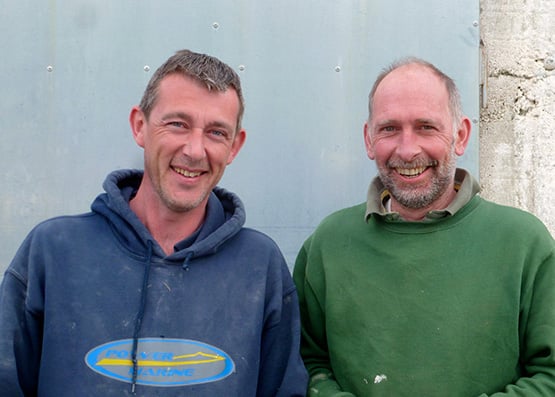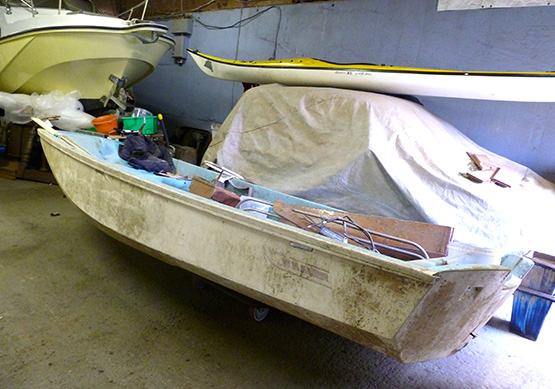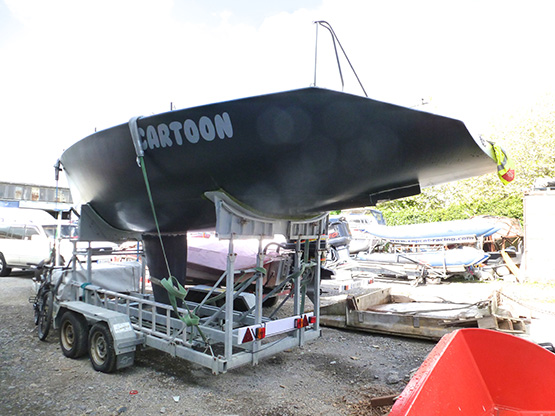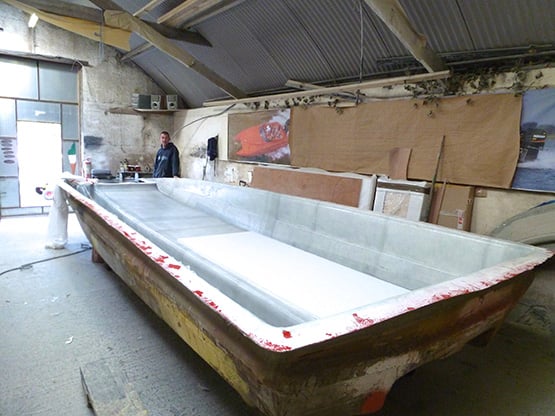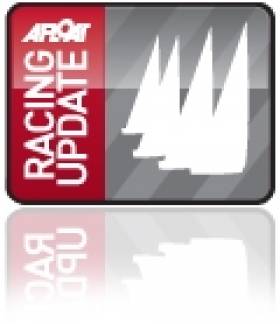Displaying items by tag: Quarter Tonner
'Great, Great Racing' is the Reason Why 25-Foot is the New Ideal Club Cruiser Racer Size in Cork Harbour
With the addition of the vintage Quarter Tonner Diamond to Royal Cork's winter league (the first to be sailed as White Sails only), the fleet provided a glimpse of the popular boat choice for club racing this summer, a season that includes Volvo Cork Week as a high point in July.
Overall, the top ten included some authentic classic designs, including an Albin Express, various Quarter Tonners, a Bolero, vintage J24s and an HB31.
 Colman Garvey and Kieran Kelleher sailing their new Quarter Tonner Diamond were the winners of Sunday's first IRC race of the Royal Cork Winter League Photo: Bob Bateman
Colman Garvey and Kieran Kelleher sailing their new Quarter Tonner Diamond were the winners of Sunday's first IRC race of the Royal Cork Winter League Photo: Bob Bateman
Further down the pecking order, there was also the appearance of Alan Mulcahy's short-lived First 8, sadly lost in a fire off Cork Harbour in Mid December as Afloat reported here.
 Tony Donworth's Quarter Tonner Supernova Photo: Bob Bateman
Tony Donworth's Quarter Tonner Supernova Photo: Bob Bateman
What's the attraction of this size of cruiser? Most likely, it is the opportunity to sail with a small crew, often made up of just family and friends. And the fact that it is cruiser racing on a budget might also have a bearing.
 Richard Leonard steering his Bolero, Bandit Photo: Bob Bateman
Richard Leonard steering his Bolero, Bandit Photo: Bob Bateman
RCYC itself has also got involved with purchasing an older J/24s as a club training boat.
 A J24 takes a ride on a Cork Harbour wave Photo: Bob Bateman
A J24 takes a ride on a Cork Harbour wave Photo: Bob Bateman
As Afloat reported previously, after a month-long series of five races, the O'Leary Insurance Winter League was won by the Albin Express, a Swedish trailerable sailboat that was designed by Peter Norlin as a cruiser-racer and first built in 1978.
Fiona Young's consistent performance at the top of the IRC fleet in North Star was rewarded with the perpetual Archie O'Leary Trophy.
On seven points, the restored Albin Express had a two-point winning margin over early series leaders Colman Garvey and Kieran Kelleher in the newly arrived Quarter Tonner, Diamond.
Third was Richard Leonard in his Bolero, Bandit on 13 points. The Bolero was designed when Quarter tonner racing was all the rage, and it was quite a successful racer, although not too many were built.
In her prize-giving speech in December, the winning helmswoman highlighted the tight racing they had enjoyed in a buoyant 32-boat fleet turnout.
 Winning form - The well-sailed Albin Express North Star skippered by Fiona Young Photo: Bob Bateman
Winning form - The well-sailed Albin Express North Star skippered by Fiona Young Photo: Bob Bateman
"This club is so active at the moment it is incredible we are all out here every Sunday. We are out here night and day, more active than I have seen the club for years", she told the fleet.
And in saluting her competitors, she revealed great competition is the reason behind the renewed focus in this particular size of boat: "You Guys in Diamond and Bandit, My Goodness! Every day we went out, we wondered who is going to do it today? We won it, but either of you could have won too. I want to thank you for that great, great racing".
Adding to the RCYC scene there are two other active clubs in Cork Harbour that have active small boat fleets that add to the lively community of sailors; Cove Sailing Club on Great Island, and Monkstown Bay Sailing Club on the western side of the River Lee.
In Cobh, there are at least five smaller sub 26ft Boats regularly racing. Two of them actively participated in all of the winter league series at RCYC; Angela, a First 260 Spirit sailed by Cathy Mullan and “NettaJ”, a Sadler 25 sailed by Des Corbett.
 Angela, a First 260 Spirit sailed by Cathy Mullan from Cove Sailing Club Photo: Bob Bateman
Angela, a First 260 Spirit sailed by Cathy Mullan from Cove Sailing Club Photo: Bob Bateman
The very successful Combined league which included all clubs in the harbour ran for a couple of seasons pre-2020 with great success and enthusiastic participation and now there are hopes to revive that event again.
Courtown Sailing Club's Quarter Tonner 'Snoopy' is Crowned ICRA Class 3 Champion on Dublin Bay
With a statement of her intent delivered last month at Calves Week in West Cork, Courtown Sailing Club Quarter Tonner 'Snoopy' is the ICRA Divison 3 National Champion at the first attempt after a superbly sailed series on Dublin Bay.
Counting seven results in the top three (and six in the top two), Joanne Hall and Martin Mahons' Wexford campaign (with Royal Ulster connections) led the three-race championship since Friday and watched other pre-championship favourites in the 11-boat fade away.
A port-starboard collision ended the highly fancied Quest's (Johnathan Skerritt) chances on day one of the regatta, and today, Paul Colton's Cri-Cri from the Royal Irish Yacht Club that was a close second going into the final two races today was pipped by Flor O'Driscoll's J24 Hard on Port from Bray Sailing Club for second overall in a building 10-knot easterly for the Sunday finale.
 Second in IRC 3 - Flor O'Driscoll's J24 Hard on Port from Bray Sailing Club
Second in IRC 3 - Flor O'Driscoll's J24 Hard on Port from Bray Sailing Club
 Third in IRC 3 - Paul Colton's Quarter Tonner Cri-Cri from the Royal Irish Yacht Club
Third in IRC 3 - Paul Colton's Quarter Tonner Cri-Cri from the Royal Irish Yacht Club
Overall results are here.
Courtown Quarter Tonner Snoopy Stays Top of IRC 3 at the ICRA Championships
Joanne Hall and Martin Mahons' Quarter Tonner Snoopy from Courtown Sailing Club (with Royal Ulster connections) continue to hold a narrow lead in Class 3 of the ICRA National Championships on Dublin Bay.
The overnight leader scored 1, 2, 2 in today's three races that puts her on 7 points overall and two points ahead of Paul Colton’s Quarter Tonner Cri Cri from the Royal Irish YC in second.
A win for Bray Sailing Club’s Flor O’Driscoll in a J/24 puts him in third place in the 11-boat fleet.
Disappointingly, pre-regatta favourite Quest did not sail today following a collision on the opening day that has put her out of the championships.
The forecast for Sunday's final two races is for SSE winds of 12 to 16 mph
Results are here.
 Paul Colton’s Quarter Tonner Cri Cri
Paul Colton’s Quarter Tonner Cri Cri
Royal Ulster Foray to West Cork's Calves Week Proves Fruitful for Mahon's Belfast Lough Quarter Tonner
Martin Mahon from Courtown Sailing Club in North Wexford is also a member of Royal Ulster Yacht Club in Bangor, having lived in Holywood on the south side of Belfast Lough for some years. He regularly sails his Joubert-Nievelt 1/4 tonner Snoopy at RUYC but wanted to experience a big event, so he chose Calves Week in West Cork. Snoopy finished second overall.
Martin made the long journey south with Snoopy on a trailer for the four-day regatta in Schull Harbour, which began on Tuesday 3rd August. Joining him were Robby and his son Josh Milhench and Gavin Watson. They sailed under the RUYC and Courtown SC flag in Class 3.
Snoopy began with a bullet in the first race on a Round the Islands course ahead of Peter O'Leary's First Class 8, Repo8. With a second in the Fastnet Race on Wednesday behind Patrick Collins' Dehler 34 Ealu from Baltimore and a third behind the same boat in the third race, also Round the Islands, they started the final race with high hopes of a big performance. But unfortunately, a friend of Martins' brought on board to boost the crew in the heavy winds of the last day, suffered a knock out in a big gust and had to be taken ashore. She is fortunately recovering. Snoopy retired and had to discard the seventh place.
Martin has returned north enthusiastic about taking part in more significant events.
It was the Quarter Tonners and associated sparring partners in IRC 3 which really got their moneys worth with ten races completed at Volvo Dun Laoghaire Regatta, but with 18 boats and white-hot competition, understandably there were times when the race results information emanating from this eclectic bunch was subsequently modified.
What is absolutely clear, however, is that Rory Fekkes from Carrickfergus with his souped-up turbo-charged Beneteau First 8 F’n Gr8 has won it outright going away – he discards a 5th and a 7th, and finishes up on 9 points from a second and seven (repeat 7) firsts to give him a total of 9.
Second overall on 23 points after an increasingly consistent performance are Brendan and Sarah Foley from RStGYC with the optimised Impala 28 Running Wild, while Ken Lawless (RIYC) is third on 31 points with the Quarter Tonner Cartoon.
IRC 4 She Too Ousts Asterix
Jonathan Fawcett’s vintage S&S-designed She 31B She Too from Abersoch was on form with a first and second today in another class which managed ten races over the series, and a re-arrangement of discards and some placing corrections saw the Welsh boat slip back into the overall lead ahead of the Sonata Asterix (Frazer Meredith & partners) while the Trapper 300 Eleint (Michal Matulka) remains in third OA.
Recently crowned ICRA Class three champion, the all-black Quarter Tonner Cartoon, skippered by Sybil McCormack and Ken Lawless, is one of three Irish Quarter Tonners competing in tomorrow's Quarter Ton Cup at the Royal Yacht Squadron in Cowes.
Only three days after the conclusion of the ICRA Nationals in Howth on Sunday, the immaculately prepared Cartoon from the Royal Irish Yacht Club is joined by another Irish Faroux design, Cobh Pirate skippered Ben Daly and also Royal Cork Yacht Club's Farr designed Anchor Challenge, skippered by Paul Gibbons, for the Solent competition.
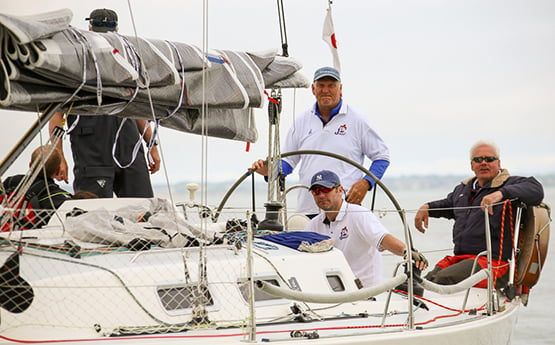
Gibbons will be joined by Mark Mansfield, (pictured on the helm above) fresh from success as tactician on Joker II in class one of the ICRAs. Mansfield, a four time Olympian, previously sailed on Anchor Challenge in 2012 when the Cork Harbour crew finished fifth in the Cup. In a busy month for the former Star helmsman, Mansfield flies home to Ireland to join another crew for the Round Ireland Race on Saturday, where he competes on Euro Car Parks, aka the J/109, Storm.
2016 marks the tenth anniversary of the revival Quarter Ton Cup. Since it was first run in 2005 the event has gone from strength to strength and Coutts' support since 2007 has been vital in helping to achieve that success.
The Coutts Quarter Ton Cup 2016 will be hosted by the Royal Yacht Squadron, Cowes, from tomorrow til Friday 17 June. As always the event will combine some of the closest and most exciting inshore racing anywhere in the world with a fun social programme and great class camaraderie.
As Afloat.ie reported previously, another new development for this year's event i s the introduction of an additional class. Class Chairman Peter "Morty" Morton explains the reasoning behind this. "What has occurred over the past few years is that the prototypes and past class winners have been upgraded considerably and in an attempt to encourage the production and older boats back to the event the organisers intend to run a second class provided sufficient numbers enter, known as the cruiser racer class. This will be for boats of a rating of 0.89 and below and for boats such as a GK24, Bolero, Quarto, Farr 727's, Eygthene 24's, Trapper 300. We know there are literally hundreds of those around and hopefully enough of them want to enjoy the regatta. They will be racing for the Roger Swinney Quarter Ton Trophy and it is intended that a round the buoys course will be set for them."
The Royal Yacht Squadron welcomed representatives of the 26 teams that will race for the Coutts Quarter Ton Cup 2016 tonight. The assembled company enjoyed a skipper's briefing followed by a welcome reception on the club's famous Platform as the sun set into the Western Solent behind them.

After an initial welcome by Colonel Tony Singer on behalf of the Royal Yacht Squadron (above), Quarter Ton Class Secretary Louise Morton thanked the club for its warm welcome and event sponsors Coutts for their ongoing support of the event which is now in its tenth year. She also thanked all the competitors for attending and particularly welcomed some new additions to the fleet.
Helleby, the 1980 Laurie Davidson design, which came second to Bullit in the Auckland Quarter Ton Cup of that year, has been tracked down by Robbie Stewart and makes her first appearance with the revival Quarter Ton fleet this week. Protis, the 1981 Fauroux design, which was built for Bruno Trouble and won that year's Cup in Marseille, has been purchased by Diarmid de Burgh Milne and comes to the event fresh from a full refit at Casse Tete Marine. Fauroux's 1989 design Tiger is well known to fleet but is under new ownership for this year's event with Tom Daniel joining the family and looking forward to his first Coutts Quarter Ton Cup.
Louise also welcomed the many old friends returning to the the event and looked forward to some fantastic racing to come. With the welcomes complete Race Officer Rob Lamb ran through the formalities for the week, confirming that racing will be run in the Solent on a mixture of laid windward leeward and fixed mark courses. He noted that Thursday's forecast for possible very heavy and thundery rain storms may limit the opportunities for racing that day, and so he announced that he intends to run four races on the opening day. Up to nine races are scheduled over the three days.
As always close racing is expected with a host of teams in with a chance of taking this year's title. Louise Morton will be defending her title aboard Bullit, but those hoping to snatch the laurels from her include Rickard Melander's Alice II, Sam Laidlaw's Aquila, Tony Haywood's Blackfun, Willy McNiell's Illegal and Ian Southworth's Whiskers, to name but a few.
The Quarter Ton Fleet is renowned for its camaraderie and love of a good party and this year's Coutts Quarter Ton Cup will give them plenty of opportunity to exercise that love, with a very special BBQ at Cowes Yacht Haven on Wednesday evening and the famous Coutts Quarter Ton Cup Gala Dinner and Prize Giving on in the Royal Yacht Squadron Pavillion on Friday evening.
Revived Coutts Quarter Ton Cup Winners
2005 - Purple Haze (1977 David Thomas design) - Tony Dodd
2006 - Enigma - (1977 Ed Dubois design) - Ed Dubois
2007 - Espada - (1980 Bruce Farr design) - Peter Morton
2008 - Tom Bombadil (1982 Doug Peterson design) - Chris Frost & Kevin George
2009 - Anchor Challenge (1978 Bruce Farr design) - Peter Morton
2010 - Cote (1990 Gonzalez design) - Darren Marston & Olly Ophaus
2011 - Overall - Espada (1980 Bruce Farr design) - Louise Morton
Corinthian - Tiger (1989 Fauroux design) - George Kenefick
2012 - Overall - Bullit - (1978 Fauroux design) - Peter Morton
Corinthian - Tiger (1989 Fauroux design) - George Kenefick
2013 - Overall - Espada - (1980 Bruce Farr design) - Louise Morton
Corinthian - Pinguin Playboy (1979 Fauroux design) - Pierre Paris
2014 - Overall - Bullit (1978 Fauroux design) - Peter Morton
Corinthain - Illes Pitiuses (1983 Fauroux) - Dominic and Jason Losty
2015 - Overall - Bullit (1978 Fauroux design) - Louise Morton
Corinthian - Pinguin Playboy (1979 Fauroux design) Pierre Paris
Notes For Editors
About The Coutts Quarter Ton Cup
The revival Quarter Ton Cup was the brainchild of well-known sailors Peter Morton and Tony Dodd. In 2004 Peter was toying with the idea of buying back his old Bruce Farr designed Quarter Tonner Super Q and Tony, the owner of Purple Haze, we keen to increase the number of boats he could race against.
A few phone calls to friends later and the idea of a revival Quarter Ton Cup was rolling. The inaugural event took place in 2005 with 14 boats attending and Purple Haze claiming victory. Each year the number and quality of the entrants has increased with the tenth anniversary event in 2014 attracting a record entry of 33 boats.
The standard of racing in the fleet is truly extraordinary with many of the best-known sailors in the world joining the racing for the sheer fun of it. Certainly the Quarter Tonners are widely acknowledged as offering some of the most competitive racing in the Solent.
Although the revival started in the Solent, the enthusiasm for Quarter Tonners is universal and there are now active Quarter Ton fleets across Europe and Australasia with more boats being rediscovered and given a new lease of life each year.
The boats are quirky, fun, incredibly challenging to sail well, but very versatile in that they are competitive in general IRC fleets. It's also a class that appeals to youngsters and those on a limited budget who can purchase a boat and refurbish her themselves at very reasonable cost. The fleet is always very supportive of new owners offering endless advice and frequently donating parts, sails and even complete rigs to deserving newcomers.
In 2007 the event partnered for the first time with title sponsor Coutts to become the Coutts Quarter Ton Cup, a partnership that has endured ever since. Coutts most generous support has been vital in making the Coutts Quarter Ton Cup the vibrant and successful regatta it is today.
The attraction of boats and the sea as a year-round fascination is something which by-passes many people. And even in summer – particularly if it’s a typical Irish summer – you’d sometimes be hard put to explain the appeal of our eccentric sport in its multiple manifestations to those who were only taking a polite interest in the first place. W M Nixon adds to the mystery by considering the unexpected interactions which come up on a typical day as the new season creaks into action.
“It’s an old Boston Whaler” says Grant McEwen, “a very old Boston Whaler. Long forgotten too, by the look of it. Most people would have thought it was fit only for the landfill site But the new owner wants it restored to best original order, proper Concours d’Elegance stuff. What do you think of that?”
“It’s absolutely marvellous” says I. “By my reckoning, the Boston Whaler in all its manifestations is classic. You just can’t do too much good work by a proper classic boat. Go for it!”
The men who work on boats in hidden workshops – Alan Power and Grant McEwen out the back of Malahide. Photo: W M Nixon
This tired-looking Boston Whaler may be as much as fifty years old, but with the proper restoration skills in Malahide she’ll be brought to Concours d’Elegance standards as a real classic. Photo: W M Nixon
We’re in one of those semi-secret little places where boat nuts gather. It’s a yard up the back of Malahide out the back of a small business park, a place where little one and two-man businesses - some of them in the marine industry - have clustered, because the reality of waterfront property in the Dublin area is that it has become much too expensive to provide decent premises for boat businesses operating on very tight margins.
Yet in these hidden and unassuming places, you’ll find some really amazing things going on. But they’re amazing only if you’re a dyed-in-the-wool boat enthusiast. So we’re not even talking about all sailing people here. Some sailing and boating people just don’t want to know about the hidden details of boats and their equipment, and how things came to be that way. They just want to go sailing, or zip around the sea under power. The work behind the scenes is not for them.
But for the rest of us, sailing and boating are of heightened interest because they’re vehicle sports. The vehicles themselves are every bit as interesting as the sport you can have with them. And from that, of course, there springs the notion that with a bit of change here and there - a minor tweak of this, and a minor adjustment of that – then hey presto, you’ve got a much improved boat.
As it happens, the finding of this Boston Whaler brought in for the Lazarus treatment was a fortuitously associated event, as I’d called to this secret yard in Malahide to shoot the breeze with one of Grant’s neighbours, Alan Power. He is known among the cognoscenti as the man to go to when you want your boat modified in interesting ways. He’s the kind of genius with epoxies and whatnot who will cheerfully take on a challenge which other workers around boats couldn’t even contemplate, let alone try.
Yet Alan will take on the job, and he has done so with such success in recent years that he has had an additional new shed built on the only spare bit of ground left in this secret yard, a shed big enough to accommodate two Half Tonners side by side.
“We’ve a World Champion out the back”. Re-vitalised Half Tonners The Big Picture (left) and World Champion Checkmate in Power Marine’s new shed in Malahide. Photo W M Nixon
Half Tonners are boats around the 30ft LOA mark which were all the rage as the hottest international level rating keelboat class around 30 years ago, when they were so highly-regarded that the likes of Olympic sailing legend Paul Elvstrom of Denmark got intensely involved. But this level of participation ultimately led to a sort of self-immolation of the class, even though the boats were still around, though now racing as ordinary handicap craft.
But as the years have passed, people have come to realize that the Half Tonner is a very manageable proposition as a classic, and thanks to modern construction, many examples of the great designs of the class’s golden years have survived remarkably well. All they need is a bit of TLC and maybe a bit of repair and tweaking here and there, and this is where Alan Power of Power Marine comes in, for no-one does it better.
The irony of it all is that Alan himself is a powerboat fanatic, both building and racing. Last weekend he was competing with the Irish contingent in the major international powerboat event at Torquay in Devon, Rounds 1 & 2 of the RYA British OCR (Offshore Racing Circuit) Championship. Roughly speaking, it’s the powerboat equivalent of saloon car racing, and this time round it was Alan’s brother Mark, navigated by Carl Kendellen, who showed best with a sixth in class and ninth overall. But in times past Alan has frequently been on the podium, and he has some Gold Medals to show for his efforts. So now that he has the new shed up and running, he has been able to devote his original shed to one of his personal pet projects, a very hungry looking powerboat to his own designs.

Mark Power’s boat was the most successful of the Irish contingent at last weekend’s Offshore Circuit Racing (ORC) event in Torquay in Devon

This British competitor at last weekend’s Torquay series was a successful Power Marine export order
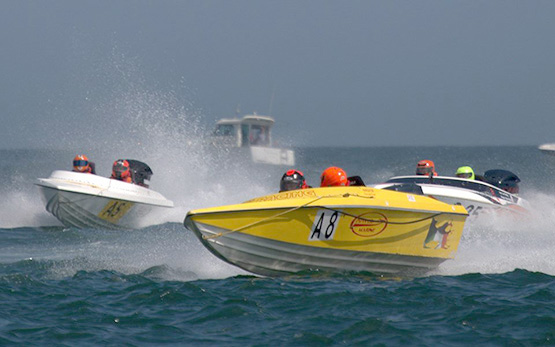
Powering ahead. Mark Power and Carl Kendellen find themselves in the sweet place in last weekend’s racing
It may seem odd that the development of a new prototype racing powerboat is in a sense being funded by the maintenance and modification requirements of handicap racing sailboats, but either way it’s specialist boat-building, and the skills are very transferable.
Fortunately, Alan hasn’t set himself too strict a deadline on this particular new craft, for with the economy picking up again, people are getting around to commissioning those modifications on sailboats that they’ve had in mind for some time, and as well there’s always a steady stream of repair work at Power Marine.
A month ago, the new shed was busy with two of the top Half Tonners in dock, Dave Cullen’s World Champion Classic half Tonner Checkmate XV and the Evans brothers’ The Big Picture. Checkmate is now afloat and competing, but The Big Picture is having further mods made, and meanwhile waiting outside is Ken Lawless’s handy little Quarter Tonner Cartoon, which is in the yard to get the Power treatment for her rudder.
Ken Lawless’s Quarter Tonner Cartoon in Power Marine for some fine tuning of the rudder
Once again, this is where boat nuts and ordinary sailors part company. For your ordinary sailor, a rudder is just a rudder. But for boat nuts, a rudder is a source of endless fascination, an item for almost eternal modification. What with creating the best-possible endplate effect at the hull, or reducing turbulence from the trailing edge, for your boat nut there’s not really a rudder on the planet which can’t be improved, however infinitesimally small the mods might be.
For non-enthusiasts, this might seem like something akin to debating how many angels can dance on the head of a pin, but I remained happily absorbed in a brief lecture by Alan – complete with sketches on a whiteboard – on the ideal configuration for the trailing edge of a rudder, which is not a knife edge as you’d expect, but is instead a small flat cutoff at about 45 degrees.
The artist in his studio – Alan Power sketching out the ideal trailing edge for a Quarter Tonner’s rudder. Photo: W M Nixon
The visit to Power Marine was prompted by a sunny Bob Bateman photo we had here on Afoat.ie a few days back of a Half Tonner swanning along in classic yachting style. This evoked contrasting memories of seeing Alan Power back in early April when work was going flat out on the two Half Tonners, and there was ample evidence of the dust-creating ability of an adult angle-grinder, with the man himself emerging from the back of the shed looking like something out of a horror movie. For sure, it’s wonderful to think of people sailing along in that healthy style as shown by the Bateman photo. But just now and again it does no harm to remember how much effort has to go into bringing a boat such as a vintage Half Tonner up to full racing potential.
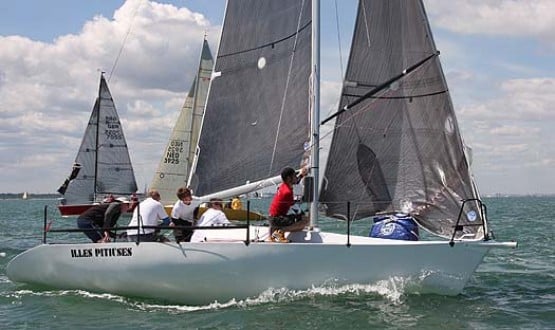
Champagne sailing. It was this idyllic image on Afloat.ie which prompted a visit to the dusty reality of a modern boatworking shed. Photo: Robert Bateman
Yet it would be pointless for all this effort to be put through in dusty premises unless the customers go out and sail and race the boat with the same dedication, and all credit to Dave Cullen, he does that very thing, and became our Sailor of the Month last August for trailing Checkmate XV to Belgium and winning the Half Ton Classics 2015.
He has an even busier season planned this year, as Checkmate has work to do at Dave’s home port of Howth in the ICRA Nationals from 10th to 12th June, but then a few days later he moves into a different scene with the complete charter of the Kelly family’s J/109 Storm, which becomes Euro Car Parks for the Volvo Round Ireland race on June 18th, crewed by five of the Checkmates plus Maurice Prof O’Connell - as the Checkmates who won the Half Ton Worlds make up a Who’s Who of Irish sailing talent, this is one potent challenge.
But Checkmate herself isn’t forgotten, for in August she has to defend her world title in Falmouth, which is as lovely a place to sail as you’ll find in a many a weeks voyaging. It’s all a very long way from a busy boatworking shed somewhere out the back of Malahide. But that’s the way it is with this crazy sport of ours.
Is it a bird? Is it a plane? Is it a bath……? No, it’s the mould for the new cathedral hull raceboat from Power Marine, which will be slightly similar to the red machine in the poster on the wall. Photo: W M Nixon
Top Quarter Tonner 'Supernova' For Sale at €14,995
The 1978 Ed Dubois designed and professionally IRC optimised Quarter Tonner Supernova is for sale for just under €15,000. The 2011 winner of Volvo Dun Laoghaire Regatta is advertised on Afloat boats for sale here.
#dlregatta – Anyone who thinks they're comprehending all the action and the full story in the continuing, colour-filled and action-packed sailfest in Dublin Bay clearly hasn't been there. You can only grasp quick visual and mental snapshots of specific classes and the sport in their racing areas, and then not only is what you're observing changing by the minute – or more accurately by the second – but something else intervenes, some other completely different boat class or incident swings into view, and you have to adjust your mind-set in jig time.
The final results of each race may put some meaning on it all. But for devotees of the unique Dublin Bay sailing scene, the results are only the tip of the iceberg. W M Nixon tells us he wouldn't presume to try to makes sense of it all, so this is just a personal take on a mega-event.
The laws of Camelot seem to prevail in Dublin Bay during these precious, priceless few days. You'll remember that in Camelot the rain is only permitted to fall at night. Well, the Camelot Code has been adhered to so far. And while there is undoubtedly rain expected from the west later today, with any luck the racing will have been completed, any heavy precipitation will pass harmlessly through during darkness, and tomorrow's final morning of racing will be sailed in that special crystal clear sunlit air which follows a damp Irish night.
We can only hope so. At the moment, as Evelyn Cusack so helpfully told us on Thursday night on RTE1 Weather, the Jetstream is swirling along vigorously, and it's close to the southward off the south coast of Ireland, creating distinctly unstable conditions.
But while the weather has been grim out west, we've seen the East Coast effect working well. You may think Wexford is Ireland's sunniest county, and so it is. But the Dublin area is the driest. Rain coming across Ireland is losing its strength as it approaches Kildare, and by the time the cloud reaches the lower Liffey Valley, that's all it is – cloud.
However, other factors are in play at this time of year, and with a bit of sunshine southerly breezes can become southeasterly sea breezes of considerable power. But the lawmakers of Camelot were so busy keeping the rain in order that they overlooked wind strengths altogether. So for the first two days, conditions have been a little brisker than some would have wished, and yesterday saw postponement for the smaller boats, but the cruiser classes were expected to slug it out as usual.
It was all a bit too much of everything, and further to complicate thing, I found myself on the opening day racing aboard a boat for which, for once, the word "iconic" is the only one that will do.
We've been following the story of Huff of Arklow and her restoration here on Afloat.ie for quite some time now. But as ever, the old Chinese saying that seeing something once is worth hearing about it a hundred times was proven abundantly true when Huff came sailing out of Belfast docks amidst the tall Ships on Sunday. Here indeed was the unique and authentic Uffa Fox design, as built by Jack Tyrrell and his craftsmen in Arklow in 1951.
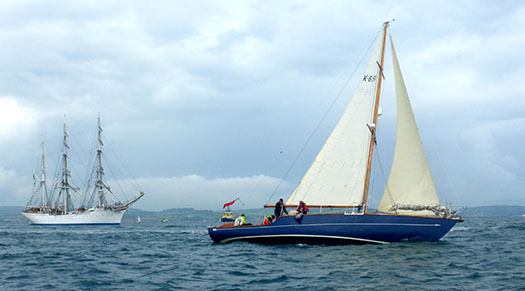
The real deal. Huff of Arklow with the Norwegian Tall Ship Statsraad Lehmkuhl on Belfast Lough last Sunday. Photo: W M Nixon
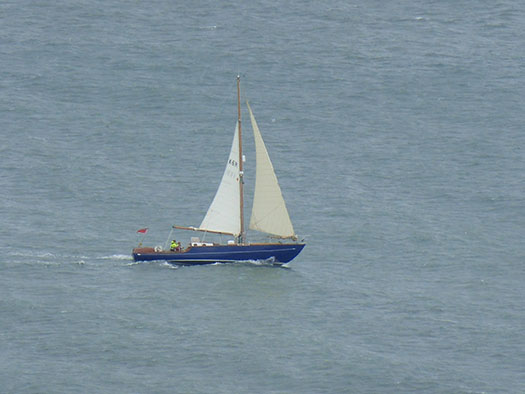
Doing what she does best. Huff of Arklow returns to Dublin Bay, as seen from the Baily at lunchtime Wednesday, after a record reaching passage from Ardglass Photo: W M Nixon
Describing her as authentic is the key to it. Since leaving Dublin Bay around 1970, Huff had undergone previous restorations, and had also survived an arson attack which miraculously left her hull intact but led to a further restoration which somehow lost the character of the boat even more.
But then in 2001 she started on the road back to a genuine restoration by being taken on by Uffa Fox enthusiast Andrew Thornhill of Bristol, who in turn saw to it that she was taken under the wing of a new classic yacht organization called Cremyll Keel Boats run by Dominic and Barbara Bridgman, and operating out of the old Mashford's boatyard at Cremyll on Plymouth Harbour.
They've re-created the flavour of Huff, they've re-captured her spirit, and in making their Dublin Bay debut at the Royal St George YC in the Volvo Dun Laoghaire Regatta 2015, they've paid their proper respects to the remarkable Douglas Heard.
In addition to being the founding President of the Irish Dinghy Racing Association in 1946, he was Commodore Royal St George YC 1960-1965, where his five innovative years in the top job were also his busy final five years with the Huff of Arklow, which he cruised and raced very extensively, with Iceland, the Azores and Portugal being visited by the distinctive dark blue boat from Ireland.
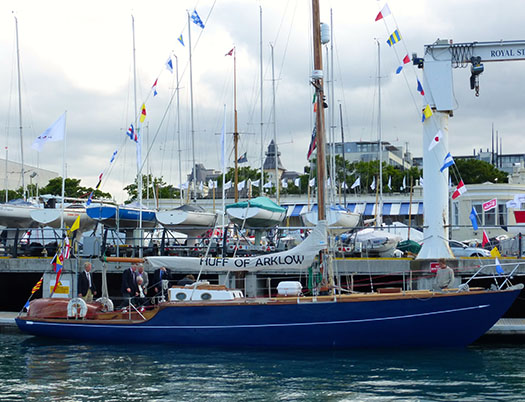 Home again – Huff of Arklow at the Royal St George YC, where she was the Commodore's yacht from 1960 to 1965. Photo: W M Nixon
Home again – Huff of Arklow at the Royal St George YC, where she was the Commodore's yacht from 1960 to 1965. Photo: W M Nixon
"Distinctive" is scarcely adequate. You'll never see anything like Huff. Basically, she's a double-size Flying Fifteen with a raised foredeck which comes well aft of amidships in order to provide impressive accommodation, and yet the low racing-style freeboard of a Flying Fifteen was retained down aft to give the new boat a very unusual appearance when she emerged from Tyrrell's yard in the spring of 1951.
But then they were used to "Mr Heard's new boat" being unusual down in Arklow, for in line with Uffa Fox's requirements, she was built with the hull upside-down in double diagonal planking. And among those who were there for Huff's welcome reception from Commodore Justin McKennna and the Royal St George members on Wednesday was Billy Murray of Arklow, who'd worked on the boat as a young trainee shipwright all those 64 years ago, and he remembered clearly that the lower freeboard aft was to help the owner get aboard the boat at moorings.
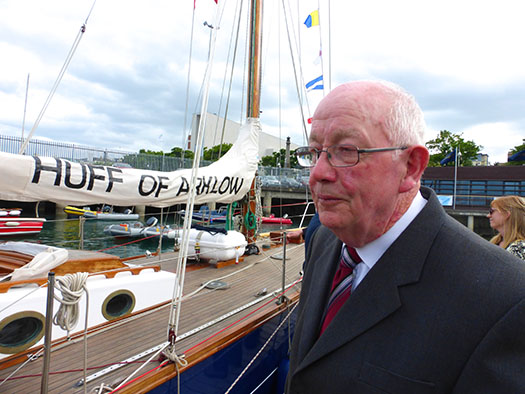
Billy Murray of Arklow, who worked on the building of Huff in the winter of 1950-51. Photo: W M Nixon
For Douglas Heard had been a wounded veteran (and a pensioner) of World War I since the age of 18, and was severely disabled in one leg. But he never let it impair his lifestyle, his zest in new things, his joy in sailing the sea, and his deep interest in boats. This was so total that he extended his seasons afloat with additional active involvement with the inland waterways.
As to how Huff performed, oddly enough she was better at cruising than racing, as she had this roomy accommodation which is very comfortable at sea, and with sheets eased she can go like a train – she arrived into Dun Laoghaire on Wednesday afternoon after a storming reach in a strong nor'wester from Ardglass in less than nine hours.
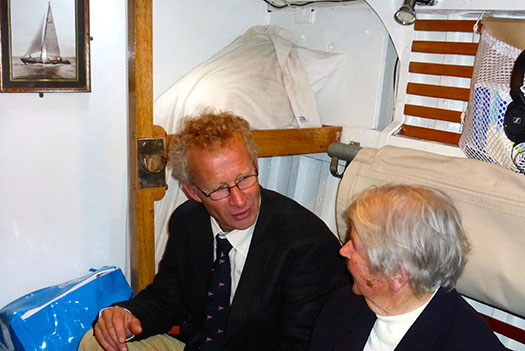
Aboard again. Ruth Heard, who sailed with her late husband Douglas on Huff of Arklow to the Azores, in the saloon with Dominic Bridgman Photo: W M Nixon
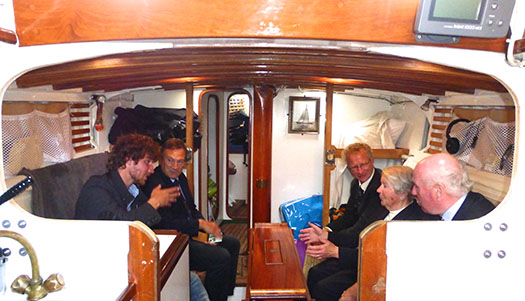
For a boat of her type, Huff of Arklow has remarkably roomy accommodation. Photo: W M Nixon
But for racing in Dublin Bay in her prime, her relatively small area of sail and her quite extensive wetted area meant that she could be sluggish in light airs, she was not at all happy to windward in a sea lumpier than the wind strength merited, and her lack of sharpness on a beat could leave her with a lot of work to do once sheets were eased.
So ideally what we would have needed on Thursday was a nice coastal course with lots of reaching. But of course, what we got was two rounds of a windward-leeward slugging match out on the middle of the bay, and the long old blue lady not at all enjoying tacking duels, and being embarrassed by having many smaller boats snapping around her heels.
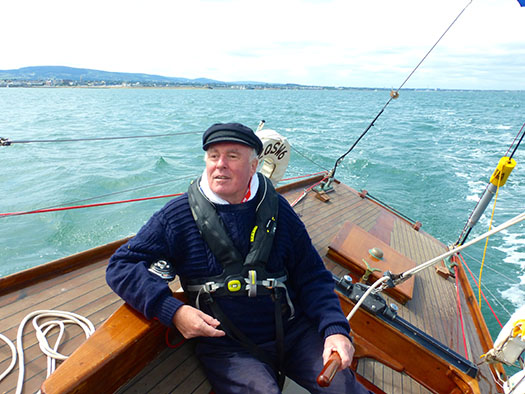
A dream comes true. Uffa Fox enthusiast Andrew Thornhill at the helm of Huff of Arklow, restored and returned to Dublin Bay after 45 years. Photo: W M Nixon
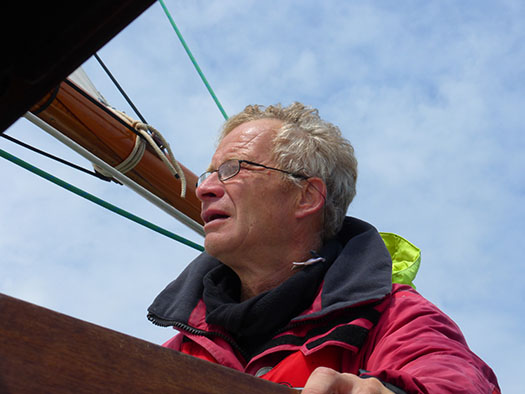 Will we clear them....? With Huff of Arklow charging along on port tack towards a gaggle of smaller more manoeuvrable boats on starboard, Dominic Bridgman has to make the call...... Photo: W M Nixon
Will we clear them....? With Huff of Arklow charging along on port tack towards a gaggle of smaller more manoeuvrable boats on starboard, Dominic Bridgman has to make the call...... Photo: W M Nixon
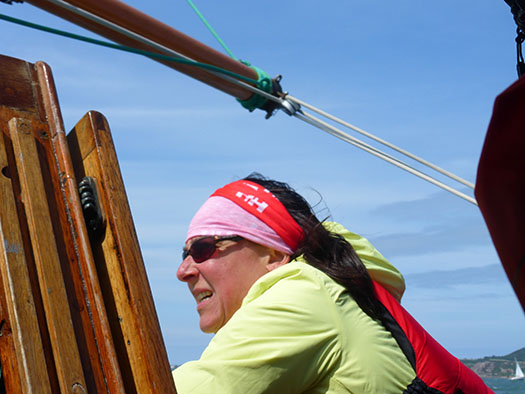 ......and he has his wife Barbara to help him get it right. Photo: W M Nixon
......and he has his wife Barbara to help him get it right. Photo: W M Nixon
Then things settled down a bit and we'd rather a good race with John Raughter's cheekily-named Fulmar 32 Chase Me from Bray SC. But this wasn't in the script at all. Chase Me wasn't even in our class. She was the next class down. However, despite there being 29 different classes in the Volvo Dun Laoghaire Regatta 2015, there wasn't a division for classics, as there doesn't seem to be a significant demand for this in Dublin Bay. And anyway, they'd need their own racing area exclusively for themselves, as many of them have highly individual handling characteristics.
So on a day when Quarter Tonners were dropping masts and our old girl with her veteran sails was at no stage being provided with her favourite point of sailing, we had to take our sport where were could find it. And if it was eventually with Cruiser Class 4 rather than our allocated Cruiser Class 3, so be it. Like the whaling skipper who went right round the world without so much as sighting a whale, let alone catching one, we had a helluva fine sail. And believe me, when Huff of Arklow came to the weather mark for the first time on this her first race in Dublin Bay in 45 years, there was pause for thought. But the old boat just tramped steadily on – she's seen it all before.
 Quite a moment. Huff of Arklow comes to the weather mark in a Dublin Bay race for the first time in 45 years. Photo: W M Nixon
Quite a moment. Huff of Arklow comes to the weather mark in a Dublin Bay race for the first time in 45 years. Photo: W M Nixon
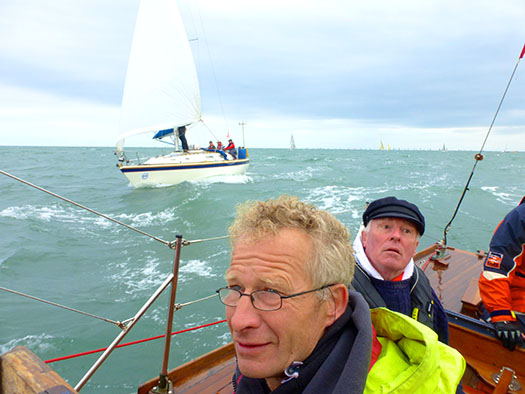 Not quite according to the script. We ended up having good sport with the Fulmar 32 Chase Me from Bray, even if she was in another class. Photo: W M Nixon
Not quite according to the script. We ended up having good sport with the Fulmar 32 Chase Me from Bray, even if she was in another class. Photo: W M Nixon
 You win some, you lose some, you drop some....... On a day when Quarter Tonners were dumping their sticks, it was good to keep a 64-year-old boat in one piece and still racing. Photo: W M Nixon
You win some, you lose some, you drop some....... On a day when Quarter Tonners were dumping their sticks, it was good to keep a 64-year-old boat in one piece and still racing. Photo: W M Nixon
Thanks to our finish being out in the middle of the bay, your columnist had the opportunity to steer Huff hard on the wind back to Dun Laoghaire Harbour. With her long slim hull and separate skeg-hung rudder, you get the impression she wouldn't turn round out of control to look at you in the manner of modern high-volume boats. But she's remarkably sensitive to fine tuning to take the weight off the helm. In order to make the harbour mouth without tacking, I asked Dominic for an extra little grind on the jib sheet, and Huff immediately responded by showing a slight hint of lee helm. But a tiny bit of haul on the mainsheet, and she was back on virtually neutral helm, with just the essential though barely perceptible weather helm required for a thoroughbred.
With a bit of help from the first of the new ebb, we made it through the harbor mouth without tacking, which provided leisure to savour the scene. You never get tired of sailing into Dun Laoghaire Harbour, and when the Volvo Dun Laoghaire Regatta is in full swing at the end of a day's racing, it's like a continuously-changing living boat show with craft of every size and shape going hither and yon, while zooming through them the foiling Moths were having themselves a tremendous time on an in-harbour course.
We came into the Berth of Honour on the pontoons at the Royal St George, and the club's Rear Commodore Sailing, Frank O'Beirne, came down to see if all was well while our ship's company seemed to find themselves talking to just about everyone on the many boats coming in close past our berth, yet somehow they also got on with the sacred task of Milling the Prosecco. It didn't take too long to decide that Huff of Arklow had just won the Flying Thirty Worlds 2015.
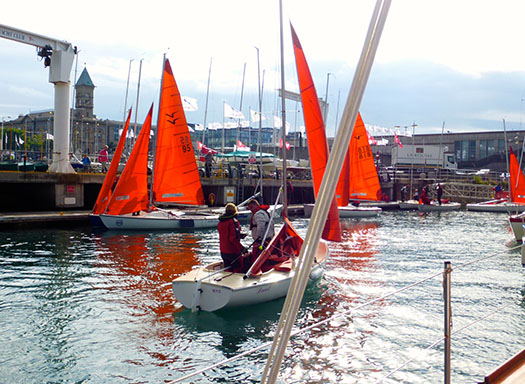
Banter time. By the time the Squbs were coming in after their race to glide close past Huff of Arklow in her Berth of Honour at the Royal St George, it had been discovered we'd just won the Flying Thirty Worlds 2015. Photo: W M Nixon
#rtir – A Cork based Quarter Tonner yacht will represent Irish hopes in Saturday's Round the Island Race. Jason Lostys Illes Pitiuses, a modified Farroux quarter ton, will compete in the Solent's Round the Island Race. The boat will be crewed by Cove Sailing club members from Cork Harbour and will also be a warm up for the Coutts Quarter Ton Cup which starts next Wednesday.































